


JAP
Jack Aerospace Publishing
Print or Kindle-eBook:
This restored Reichenberg shows the clean lines of this small aircraft. Designed as a
compromise solution, it had some weaknesses. But if one can neglect the intended
purpose for a moment, it was very effective from an aircraft construction standpoint.
The piloted missile Reichenberg was carried by a Heinkel He 111 bomber into the air.
Like this unmanned V-1 missile here in the photo, the Reichenberg was mounted
under the starboard wing - for tests flights and for the proposed suicide missions.
An allied soldier poses as the pilot in a Reichenberg at
the Dannenberg facility. In the cramped cockpit there is
no chance to jump out for a rescue by parachute.
Luftwaffe pilots volunteered for the suicide mission
Because most of the first volunteers for a suicide mission were glider pilots, the
Gothaer Waggonfabrik aviation company designed a glider with a heavy explosive
payload. But the development of this aircraft would take too long to be operational
against the allied invasion in France. It was decided to use an already existing aircraft,
the Messerschmitt Me 328. But this would need a large carrier aircraft, not available in
numbers in the Luftwaffe.
So the emergency solution was to fit the missile V-1 with a cockpit. The bomber
Heinkel He 111 could launch one V-1 in flight and would do this with the piloted version
too. This aircraft was called “Reichenberg”.
The cockpit of one of the restored Reichenberg aircraft. Alexander
Kuncze did a great job here. From left to right: Rotary knob for
regulating the air pressure stream to the fuel tank. Release lever for
the canopy, the fuel valve, starter lever and fuel filter below. The
instrument panel with arming switch for the warhead, clock (often
missing in operational aircraft), speedometer, altimeter and artificial
horizon. Compass on the battery and converter. Control stick is in the
foreground.
Various experimental versions and training aircraft were built and tested. There
were also fatal accidents, the Reichenberg was only an emergency solution.
About 175 Reichenberg were built for the real suicide mission, but as far as it is
known, never used. Under Command of the most secret Kampfgeschwader
KG 200, a suicide unit was established as the 5. Staffel - the pilots called
themselfs “Leonidas”-Staffel. The official name, however, was Selbstopfer-Staffel.
abbreviated as SO-Staffel.
U.S. troops discovered and captured several Reichenberg and unmanned
V-1 missiles at Dannenberg in central Germany. One example of the
unusual aircraft was pulled out of the building.
The German commander of Dannenberg, Major Fritz Hahn (back
to camera), surrenders to Lieutnant Enno Hobbing and Lieutnant
Colonel Long McFarleand (sitting in the Reichenberg!) of the 5th
Armored Division of the U.S. Army at April 23, 1945.
The complete Ju 287-Story in one Volume!
Reichenberg - the piloted V-1 missile
To date there have been numerous misinterpretations
about the back-ground of the Luftwaffe suicide
operation, the motivation of the pilots and the
technology of the „Reichenberg" flying bomb.
You will find many photographs and drawings of
the different versions of the „Reichenberg" trainer and
operational aircraft. A restoration in Germany of three
surviving suicide aircraft offered the chance to provide
this publication with many detailed photographs.
The author had the unique chance to speak to
three former Luftwaffe pilots who volunteered for a
suicide mission.
More than 100 pictures
63 pages
large format: 21.6 x 27.9 cm (8.5” x 11”)
Sample pages

Text: English plus German
Document collection:
Reichenberg and Luftwaffe suicide operations
This collection of extremely rare documents is intended to help historians and
aeronautical researchers gain a deeper look at this dark chapter of the Air War
over Europe from 1939 to 1945.
Some German documents published here appear to be of very poor
quality. This is not due to the reproduction in print. Some of the original sheets
are only carbon copies or were found outdoors. With all of them, the paper has
become very dark and the writing has faded due to the decades of storage.
The summaries in English reflect the most important passages from the
German documents. Based on these short texts, however, the development
should become clear to the reader. Texts in quotation marks are verbatim
translations of a passage.
71 pages
Towards the end of the Second World War, German pilots voluntarily crashed on
their targets with bomb-laden conventional aircraft. Desperate to stop the Allied
bombing raids on German cities and to prevent the Allied occupation of Germany,
over 1,000 young Luftwaffe pilots had volunteered from 1943 on for a suicidal
flight with a manned bomb.
After the attempt to design a special aircraft for this purpose failed, as a quick
solution some V-1 missiles were provided with a cockpit and named
„Reichenberg“. And in the Luftwaffe the „Leonidas“-suicide-squadron was formed.


Reichenberg - the piloted V-1
The suicide weapon of the Luftwaffe
A short summary
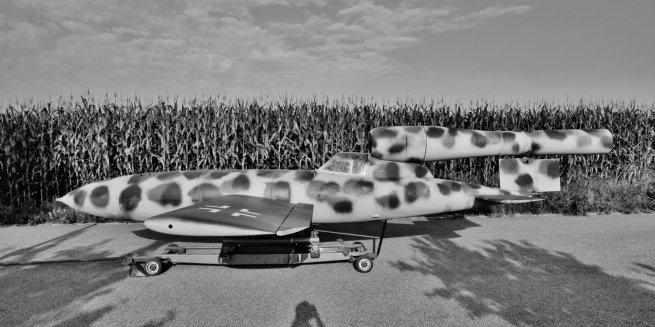
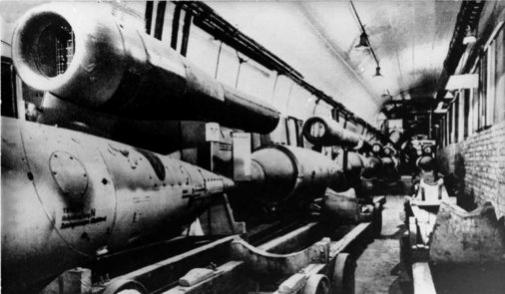
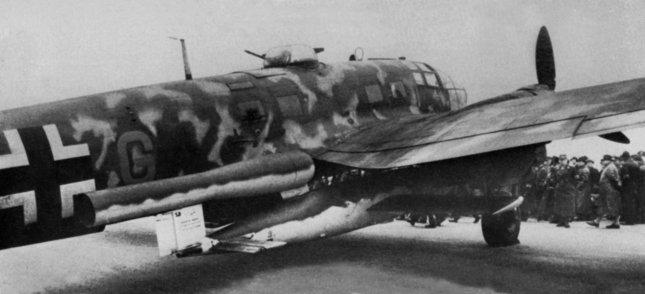
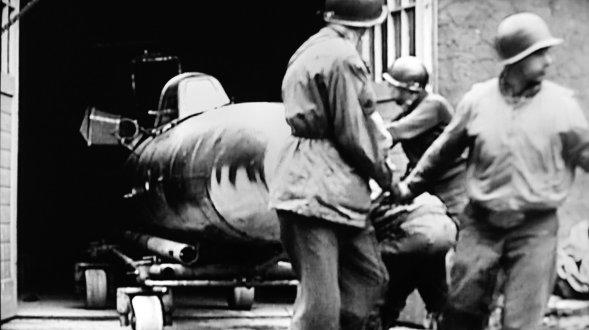


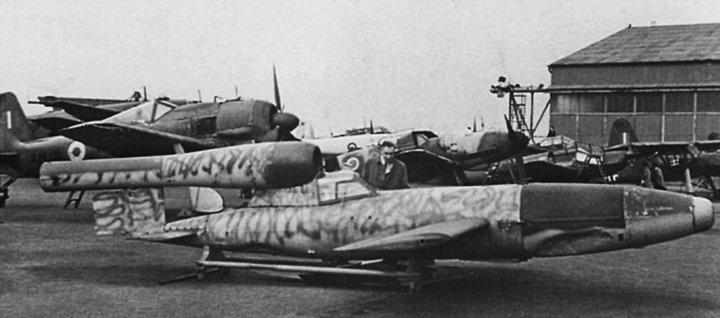



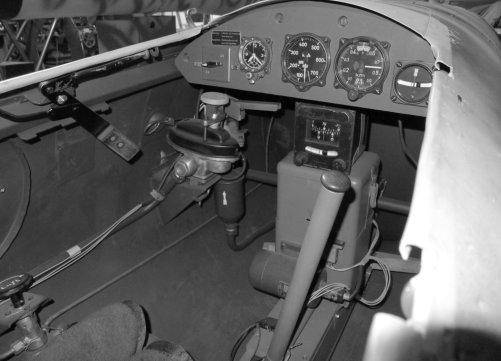

Production of V-1 missiles in the tunnels of the Mittelwerk/Dora
facility in the Harz mountains. The Reichenberg was produced
here too.
Anyone who has purchased a copy of the Reichenberg publication can
download the color profiles here, that are black and white in the booklet.
The authorization code for this can be found in the book.
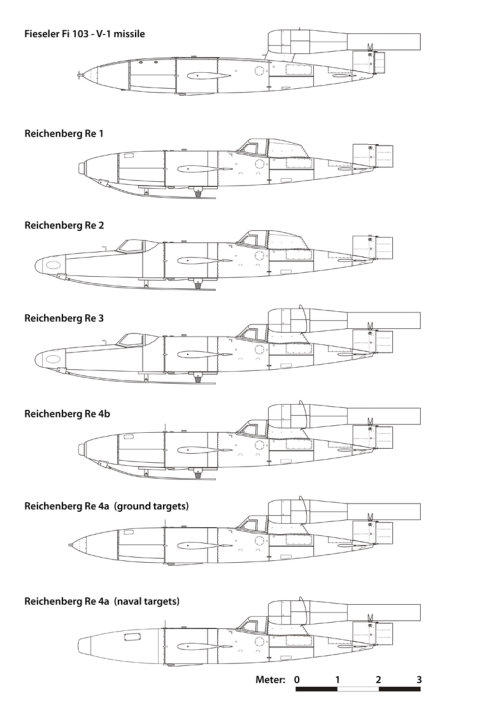
This overview shows the versions of the Reichenberg as trainer or
suicide aircraft compared to the unmanned V-1 at the top.


This picture from the Fieseler works at Kassel after the war‘s end shows interesting
details. From left to right: A cockpit section of a Junkers Ju 388, a Jumo 004 jet
engine and a Reichenberg trainer fuselage ready for shipment. This indicates that
Re 2/Re 3 trainers were produced until the final collapse of Germany. Then there
are three BMW 003 jet engines and one more Jumo 004 in front of fin and tail units
from the jet fighter Messerschmitt Me 262.
After the war‘s end in Europe, an exhibition of Luftwaffe aircraft was opened to the
public at Farnborough airfield. The Reichenberg attracted much attention by the visitors.
A curved wooden piece positioned for some times under the fuselage misleaded many
authors to a wrong length and position of the landing skid of the trainer version.



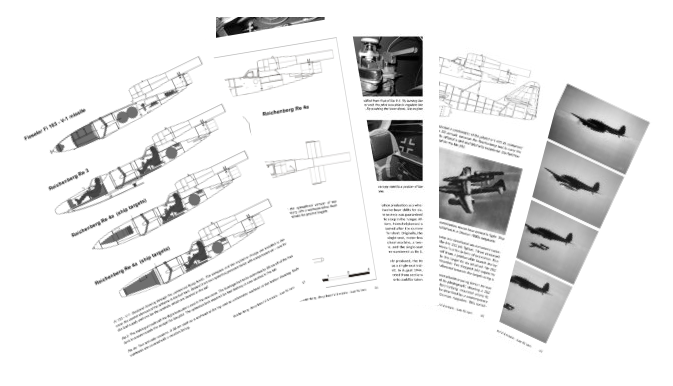



Print or Kindle-eBook:









